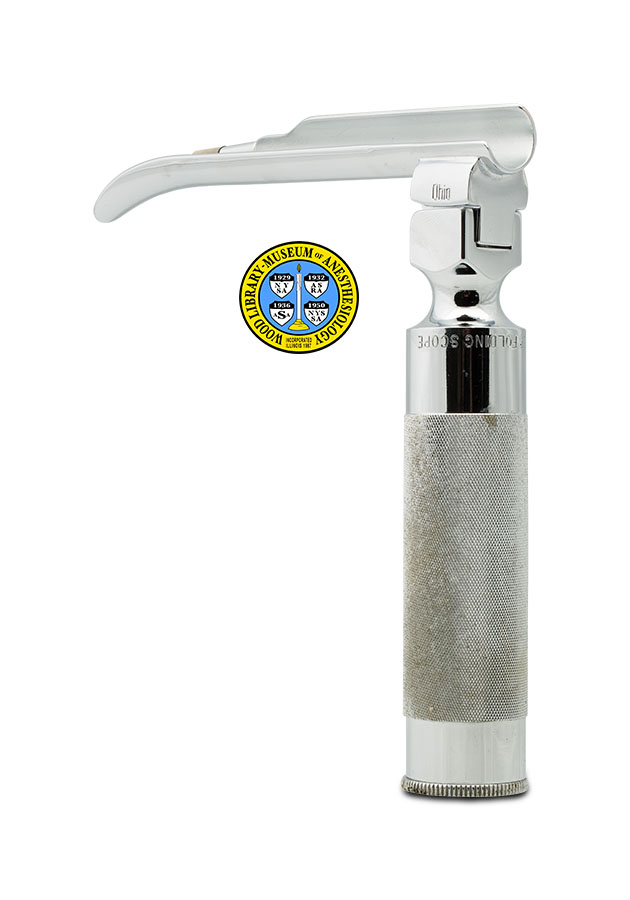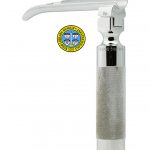Phillips Laryngoscope
Anesthesiologists are responsible for maintaining the patient's respiration and other vital functions during surgery. They may use a laryngoscope to view the patient's larynx (voice box) and insert a breathing tube between the vocal cords and into the trachea (windpipe.) The blade is the part of the laryngoscope that enters the patient's mouth. Conditions such as protruding teeth or a swollen tongue can make intubation difficult.
Anesthesiologist Otto C. Phillips, M.D. (1917-1981) and otolaryngologist Roger L. Duerksen, M.D., were both affiliated with the University of Pittsburgh School of Medicine. Together they studied the most commonly used laryngoscopes in order to develop a design that would "make both visualization of the larynx and intubation possible in the most difficult cases, and for the widest spectrum of patients." They introduced their new laryngoscope in 1973. It combines the shaft of the Jackson direct laryngoscope (introduced in 1912) and the curved tip of the Miller laryngoscope (introduced in 1941). The example shown here was made by Ohio Medical Products between 1973 and 1984. The Phillips blade continues to be made today by several companies.
Catalog Record: Phillips Laryngoscope Phillips Laryingoscope
Access Key: aqlb
Accession No.: 1987-05-27-1 E
Title: [Phillips Laryngoscope / designed by Otto C. Phillips].
Author: Phillips, Otto C. (1817-1981).
Publisher: Madison, Wisconsin : Ohio Medical Products, [between 1973 and 1984].
Physical Description: 1 laryngoscope blade : metals, glass ; 3.5 x 2 x 16 cm.
Subject: Anesthesia, Inhalation – instrumentation.
Subject: Laryngoscopes – battery-powered.
Subject: Laryngoscopes – straight blades.
Note Type: General
Notes: The first year in the range of possible dates of manufacture is based on the date of introduction. The second year in the date range is the year that Ohio Medical Products changed its name to Ohmeda.
Described from the perspective of the patient. The tip is considered the front and the hub is the back. The concave side of the blade is the top.
Married to handle, accession # 2004-03-03-1 H for purposes of photography.
The manufacturer was identified by the distinctive logo stamped on the object.
Note Type: Citation
Notes: Hung OR, Murphy MF, eds. Management of the Difficult and Failed Airway. New York: McGraw Hill Medical, 2008:109.
Note Type: Citation
Notes: Phillips OC, Duerksen RL. Endotracheal intubation: a new blade for direct laryngoscopy. Anesth Analg. September-October, 1973;52(5):691-697.
Note Type: Citation
Notes: Phillips O, inventor. Laryngoscope blade. US Patent 3,856,001. December 24, 1974.
Note Type: Citation
Notes: Phillips, Otto C., 1817-1981 [biographical file]. Archives. Located at: Wood Library-Museum of Anesthesiology, Schaumburg, Illinois.
Note Type: Physical Description
Notes: One laryngoscope blade; The curve of the blade occupies approximately the last 4 centimeters, becoming more pronounced at the tip; A light bulb is mounted on the exterior of the bade on the right side; The blade has a snap-on hub, which is marked “PHILLIPS 2 [new line] A C” on the left side, and “Ohio” on the right side.
Note Type: Reproduction
Notes: Photographed by Mr. Steve Donisch, June 20, 2017.
Note Type: Acquisition
Notes: Gift of Francis Jones, M.D.
Note Type: Historical
Notes: Anesthesiologists are responsible for maintaining the patient’s respiration and other vital functions during surgery. For general, or inhalation, anesthesia, they may use a laryngoscope to view the patient’s larynx (voice box) and insert a breathing tube through the trachea (wind pipe.) Conditions such as a high larynx, protruding teeth or a swollen tongue, can make intubation difficult.
Otto C. Phillips, M.D. (1917-1981) served as a Clinical Professor of Anesthesiology at the University of Pittsburgh School of Medicine, Pittsburgh, Pennsylvania., and later as the Chief of the Division of Anesthesiology at the affiliated Western Pennsylvania Hospital. Together with otolaryngologist Roger L. Duerksen, M.D., he developed a new laryngoscope to “make both visualization of the larynx and intubation possible in the most difficult cases, and for the widest spectrum of patients.” They introduced their laryngoscope in 1973, and Dr. Phillips was granted a patent for it design the following year.
In their description of the blade, they reported that they had reviewed the various direct and indirect laryngoscopy techniques afforded by different blade designs and concluded that direct laryngoscopy was “the least traumatic”. They then studied the three most common types in use: straight blades (such as the Jackson Direct laryngoscope), straight blades with a curved tip (such as the Miller blade), and curved blades (such as the Macintosh). They observed that a given blade might give good exposure (visibility) of the larynx but poor access for intubation, and vice versa.
In their 1973 description Phillips and Duerksen state that a curved blade is “the least traumatic”, and further, that exposure of the larynx is “usually not as adequate with a straight blade”. Despite this, the Phillips laryngoscope has a straight blade with a curved tip. They state that their new instrument combines “features of the Jackson and Miller blades, the shaft of the Jackson and the curved tip of the Miller.”
The Phillips laryngoscope was originally made by the Foregger Company. The cataloged object was made by Foregger’s chief competitor, Ohio Medical Products. Established in 1910, the Ohio Chemical & Surgical Equipment Co. changed its name to Ohio Medical Products in 1967. The company’s name changed to Ohmeda in 1984. The Phillips blade continues to be made today by several companies. The makers found in the cataloger’s review of numerous supplier’s online catalogs, dated 2017, were Heine, Mercury , Rusch and Sun-Med.
Note Type: Exhibition
Notes: Selected for the WLM website.


